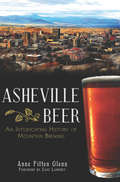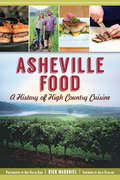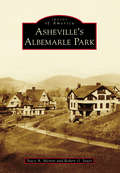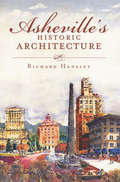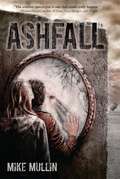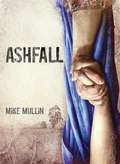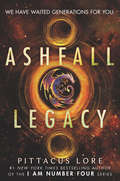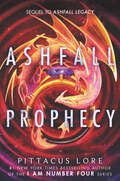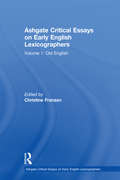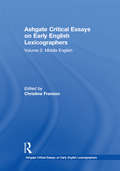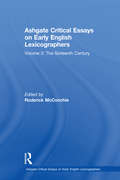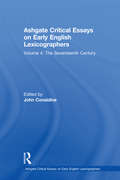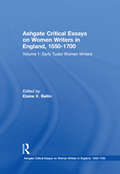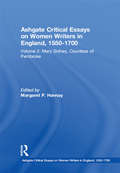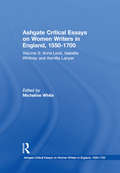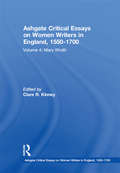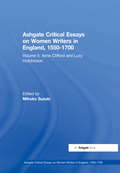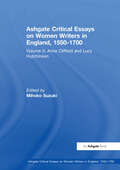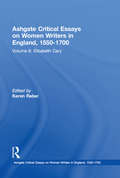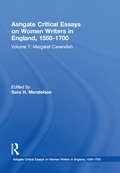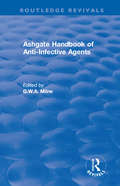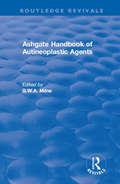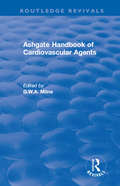- Table View
- List View
Asheville Beer: An Intoxicating History of Mountain Brewing (American Palate)
by Anne Fitten GlennDrinking local harks back to the founding of Asheville in 1798. Whether it be moonshine or craft beer, the culture of local hooch is deeply ingrained in the mountain dwellers of Western North Carolina. Both residents and visitors alike enjoy Asheville's wealth of breweries, brewpubs, beer festivals and dedicated retailers. That enthusiasm earned the city the coveted Beer City, USA title year after year and prompted West Coast beer giants Sierra Nevada, New Belgium and Oskar Blues to establish production facilities here. Beer writer and educator Anne Fitten Glenn recounts this intoxicating history, from the suds-soaked saloons of 'Hell's Half Acre" to the region's explosion into a beer Mecca.
Asheville Food: A History of High Country Cuisine (American Palate)
by Rick McdanielThirty years ago, the mountain city of Asheville was known for little more than the Biltmore Estate. Since then, the sleepy town has become a nationally recognized food mecca, a hot spot for food celebrities and a bustling hub of microbreweries. Food historian and author Rick McDaniel traces the rise of the Asheville food scene from its early eateries to the pioneering chefs who put Asheville on the culinary map and the new generation of stars who command the kitchens at the city's hottest new restaurants. A founding city of the farm-to-table movement, Asheville is proud of its local food and drink, appearing on creative menus throughout the city and in the pages of the national food media. Join McDaniel as he embarks on a mouthwatering journey to explore the farmers, chefs, markets and history that have shaped Asheville's rich food heritage.
Asheville's Albemarle Park
by Robert O. Sauer Stacy A. MertenAlbemarle Park was envisioned as a picturesque mountainside resort in north Asheville. It was a great success due to the collaborative efforts of railroad executive William Greene Raoul and his son Thomas; Bradford Gilbert, architect of New York City's first skyscraper; and Samuel Parsons Jr., landscape architect for the City of New York. The Manor and its surrounding cottages served as an alternative to standard late-19th-century Asheville hotels and boardinghouses. Dances, plays, bowling, archery, golf, motoring, and equestrian events were available for guests to enjoy, and meals were sourced from The Manor's own farm. Notable guests of The Manor included Eleanor Roosevelt and Grace Kelly. It was also a film set for The Last of the Mohicans. Consisting of enchanting architecture and romantic landscaping, Albemarle Park was listed in the National Register of Historic Places in 1977 and as a local historic district in 1989. Through family archives, private collections, and ephemera, Asheville's Albemarle Park showcases the history of this significant Asheville neighborhood.
Asheville's Historic Architecture (Landmarks)
by Richard HansleyAsheville, known for its architectural diversity and intriguing Art Deco style, has been fortunate in attracting brilliant architects who, with imaginative foresight and design expertise, have created lasting testaments in brick and stone. Local architectural enthusiast Richard Hansley recounts the history behind dozens of Asheville's most prominent buildings and historical neighborhoods in Asheville's Historic Architecture. Discover how Douglas Ellington, Richard Sharp Smith, James Vester Miller and Tony Lord influenced this busy metropolis, as landmarks like the Jackson Building, the Grove Park Inn and the Art Deco City Building were constructed along the city's thriving streets. These buildings have stood the test of time and remain as breathtaking in concept and appearance today as when first completed.
Ashfall
by Denise A. AgnewA strong-willed woman and a former Air Force pararescueman have learned to survive in a new world forged by an apocalypse no one could have stopped. Isolated and alone, Mally Andretti finds hope in the tantalizing voice she hears on her ham radio, a man who says he's her friend. But in a world-gone-crazy, danger looms around every corner and it's hard to know who to trust. Denise A. Agnew presents Ashfall, book one in her exciting new series, The Wasteland Trilogy.After surviving an apocalypse, lonely Mally should feel safe. Until a deep, mysterious voice over the ham radio invites her into soul deep conversation and awakens mental and physical cravings.Her voice calls on every fiercely protective instinctive inside Adam, and when she's in danger he'll do anything to protect her.Content Notes: Spicy, Urban Fantasy, Post-Apocalyptic, Suspense, Uniformed Heroes
Ashfall (Ashfall Series #1)
by Mike Mullin<P>Many visitors to Yellowstone National Park don't realize that the boiling hot springs and spraying geysers are caused by an underlying supervolcano, so large that the caldera can only be seen by plane or satellite. And by some scientific measurements, it could be overdue for an eruption. <P>For Alex, being alone for the weekend means freedom from his parents and the chance to play computer games and hang out with his friends without hassle from his mother. <P>Then the supervolcano erupts, plunging his hometown into a nightmare of darkness, ash, and violence. Alex begins a harrowing trek, searching for his family and finding help in Darla, his travel partner. Together they must find the strength and skills to survive and outlast an epic disaster.
Ashfall (Ashfall Trilogy)
by Mike MullinMany visitors to Yellowstone National Park don't realize that the boiling hot springs and spraying geysers are caused by an underlying supervolcano, so large that the caldera can only be seen by plane or satellite. And by some scientific measurements, it could be overdue for an eruption.For Alex, being left alone for the weekend means having the freedom to play computer games and hang out with his friends without hassle from his mother. Then the Yellowstone supervolcano erupts, plunging his hometown into a nightmare of darkness, ash, and violence. Alex begins a harrowing trek to seach for his family and finds help in Darla, a travel partner he meets along the way. Together they must find the strength and skills to survive and outlast an epic disaster.
Ashfall Legacy
by Pittacus LorePittacus Lore finished telling the story of the Lorien Nine in the New York Times bestselling I Am Number Four and Lorien Legacies Reborn series. Now he’s back to recount an all-new adventure rooted in the real mysteries surrounding Roswell, New Mexico, that will enthrall fans of Brandon Sanderson, Jay Kristoff, and Amie Kaufman. We have waited generations for you… Syd Chambers knows that there’s life on other planets because he’s descended from it. His father was from a distant world called Denza and has been missing—presumed dead—for years. When Syd discovers a device his father left behind which shows not only that he’s alive, but where he is, Syd must set out on a mission of his own. But along the way, he discovers a deadly, unbearable secret that could destroy Denza, Earth, and the universe.
Ashfall Prophecy
by Pittacus LorePittacus Lore finished telling the story of the Lorien Nine in the New York Times bestselling I Am Number Four and Lorien Legacies Reborn series. Now he’s back with the second installment in an all-new adventure duology rooted in the real mysteries surrounding Roswell, New Mexico, that will enthrall fans of Brandon Sanderson, Jay Kristoff, and Amie Kaufman. Syd Chambers grew up on Earth with his human mother and barely remembers his alien father from Denza, who left on a mission when Syd was very young. After leaving Earth, Syd learned the truth of his father’s disappearance on the planet Ashfall—his father had died protecting a devastating secret about the history between humans and Denzans.Syd is now faced with a choice—free humanity from imprisonment on Earth, which will allow them to come into physical power beyond their wildest dreams; or destroy Earth so that humans never have a chance to enslave, torment, and kill other species again. It has been prophesied that Syd is destined to become a world-killer, but Syd is determined to choose his own fate, and knows there must be another path forward that will honor his father’s sacrifice.
Ashgate Critical Essays on Early English Lexicographers: Volume 1: Old English (Ashgate Critical Essays on Early English Lexicographers)
by Christine FranzenAnglo-Saxon lexicography studies Latin texts and words. The earliest English lexicographers are largely unidentifiable students, teachers, scholars and missionaries. Materials brought from abroad by early teachers were augmented by their teachings and passed on by their students. Lexicographical material deriving from the early Canterbury school remains traceable in glossaries throughout this period, but new material was constantly added. Aldhelm and Ælfric Bata, among others, wrote popular, much studied hermeneutic texts using rare, exotic words, often derived from glossaries, which then contributed to other glossaries. Ælfric of Eynsham is a rare identifiable early English lexicographer, unusual in his lack of interest in hermeneutic vocabulary. The focus is largely on context and the process of creation and intended use of glosses and glossaries. Several articles examine intellectual centres where scholars and texts came together, for example, Theodore and Hadrian in Canterbury; Aldhelm in Malmesbury; Dunstan at Christ Church, Canterbury; Æthelwold in Winchester; King Æthelstan's court; Abingdon; Glastonbury; and Worcester.
Ashgate Critical Essays on Early English Lexicographers: Volume 2: Middle English (Ashgate Critical Essays on Early English Lexicographers)
by Christine FranzenThe teaching of Latin remained important after the Conquest but Anglo-Norman now became a language of instruction and, from the thirteenth century onwards, a language to be learned. During this period English lexicographers were more numerous, more identifiable and their works more varied, for example: the tremulous hand of Worcester created an Old English-Latin glossary, and Walter de Bibbesworth wrote a popular contextualized verse vocabulary of Anglo-Norman country life and activities. The works and techniques of Latin scholars such as Adam of Petit Point, Alexander Nequam, and John of Garland were influential throughout the period. In addition, grammarians' and schoolmasters' books preserve material which in some cases seems to have been written by them. The material discussed ranges from a twelfth-century glossary written at a minor monastic house to four large alphabetical fifteenth-century dictionaries, some of which were widely available. Some material seems to connect with the much earlier Old English glossaries in ways not yet fully understood.
Ashgate Critical Essays on Early English Lexicographers: Volume 3: The Sixteenth Century (Ashgate Critical Essays on Early English Lexicographers)
by Roderick McConchieLaying the foundations for the first monolingual dictionaries of English, the sixteenth century in English lexicography is here shown to form a bridge between the glossarial compilations which had slowly evolved during the Middle Ages, and the more recognisably modern dictionary incorporating synonymy, illustrative citations and other standard features. The articles collected here treat general lexicography and dictionaries in this period, their uses, and the state of research in this field. The volume also covers a fascinating and diverse collection of lexicographers, from the well known - John Palsgrave, Thomas Cooper, Thomas Elyot and John Florio - to those about whom next to nothing is known - Richard Howlet, John Baret and Peter Levens.
Ashgate Critical Essays on Early English Lexicographers: Volume 4: The Seventeenth Century (Ashgate Critical Essays on Early English Lexicographers)
by John ConsidineThree major developments in English lexicography took place during the seventeenth century: the emergence of the first free standing monolingual English dictionaries; the making of new kinds of English lexicons that investigated dialect or etymology or that keyed English to invented 'philosophical' languages; and the massive expansion of bilingual lexicography, which not only placed English alongside the European vernaculars but also handled the languages of the new world. The essays in this volume discuss not only the internal history of lexicography but also its wider relationships with culture and society.
Ashgate Critical Essays on Early English Lexicographers: Volume 5: The Eighteenth Century (Ashgate Critical Essays on Early English Lexicographers)
by Anne C. McDermottThe eighteenth century is renowned for the publication of Samuel Johnson's A Dictionary of the English Language, which reference sources still call the first English dictionary. This collection demonstrates the inaccuracy of that claim, but its tenacity in the public mind testifies to how decisively Johnson formed our sense of what a dictionary is. The essays and articles in this volume examine the already flourishing tradition of English lexicography from which Johnson drew, as represented by Kersey, Bailey, and Martin, as well as the flourishing contemporary trade in encyclopedic, technical, pronunciation, and bilingual lexicons.
Ashgate Critical Essays on Women Writers in England, 1550-1700: Volume 1: Early Tudor Women Writers (Ashgate Critical Essays on Women Writers in England, 1550-1700 #Vol. 1)
by Elaine V. BeilinThis volume includes leading scholarship on five writers active in the first half of the sixteenth century: Margaret More Roper, Katherine Parr, Anne Askew, Mildred Cooke Cecil and Anne Cooke Bacon. The essays represent a range of theoretical approaches and provide valuable insights into the religious, social, economic and political contexts essential for understanding these writers' texts. Scholars examine the significance of Margaret More Roper's translations and letters in the contexts of humanism, family relationships and changing cultural forces; the contributions of Katherine Parr and Anne Askew to Reformation discourses and debates; and the material presence of Mildred Cooke Cecil and Anne Cooke Bacon in the intellectual, religious and political life of their time. The introduction surveys the development of the field as an interdisciplinary project involving literature, history, classics, religion and cultural studies.
Ashgate Critical Essays on Women Writers in England, 1550-1700: Volume 2: Mary Sidney, Countess of Pembroke (Ashgate Critical Essays on Women Writers in England, 1550-1700)
by Margaret P. HannayMary Sidney Herbert, Countess of Pembroke, was renowned in her own time for her metrical translation of biblical Psalms, several original poems, translations from French and Italian, and her literary patronage. William Shakespeare used her Antonius as a source, Edmund Spenser celebrated her original poems, John Donne praised her Psalmes, and Lady Mary Wroth and Aemilia Lanyer depicted her as an exemplary poet. Arguably the first Englishwoman to be celebrated as a literary figure, she has also attracted considerable modern attention, including more than two hundred critical studies. This volume offers a brief introduction to her life and an extensive overview of the critical reception of her works, reprints some of the most essential and least accessible essays about her life and writings, and includes a full bibliography.
Ashgate Critical Essays on Women Writers in England, 1550-1700: Volume 3: Anne Lock, Isabella Whitney and Aemilia Lanyer (Ashgate Critical Essays on Women Writers in England, 1550-1700)
by Clements R. MarkhamAnne Lock, Isabella Whitney and Aemilia Lanyer have emerged as important literary figures in the past ten years and scholars have increasingly realized that their bold and often unorthodox works challenge previously-held conceptions about women's engagement with early modern secular and religious literary culture. This volume collects some of the most influential and innovative essays that elucidate these women's works from a wide range of feminist, literary, aesthetic, economic, racial, sexual and theological perspectives. The volume is prefaced by an extended editorial overview of scholarship in the field.
Ashgate Critical Essays on Women Writers in England, 1550-1700: Volume 4: Mary Wroth (Ashgate Critical Essays on Women Writers in England, 1550-1700)
by Mary Wroth and Clare R. KinneyThe last twenty-five years have seen exciting new developments in scholarly work on Lady Mary Wroth, whose Urania and Pamphilia to Amphilanthus constitute the first romance and the first sonnet sequence to be published by an Englishwoman. Wroth's writings enter into a suggestive and gendered dialogue with the lyric and narrative works of her uncle, Sir Philip Sidney, even as they carve out a place for her own literary experiments. This volume gathers together some of the most striking recent criticism addressing Wroth's oeuvre; many of its essays also discuss the intellectual and cultural contexts in which she wrote. The collection is prefaced by an extended editorial overview of scholarship in the field.
Ashgate Critical Essays on Women Writers in England, 1550-1700: Volume 5: Anne Clifford and Lucy Hutchinson
by Anne Clifford Lucy HutchinsonUntil recently, Anne Clifford has been known primarily for her Knole Diary, edited by Vita Sackville-West, which recounted her steadfast resistance to the most authoritative figures of her culture, including James I, as she insisted on her right to inherit her father's title and lands. Lucy Hutchinson was known primarily as the biographer of her husband, a Puritan leader during the English Civil Wars. The essays collected here examine not only these texts but, in Clifford's case, her architectural restorations and both the Great Book which she had compiled and the Great Picture which she commissioned, in order to explore the identity she fashioned for herself as a property owner, matriarchal head of her family, patron and historian. In Hutchinson's case, recent scholars have turned their attention to her poetry, her translation of Lucretius and her biblical epic, Order and Disorder, to analyze her contributions to early modern scientific and political writing and to place her work in relation to Milton's Paradise Lost.
Ashgate Critical Essays on Women Writers in England, 1550-1700: Volume 5: Anne Clifford and Lucy Hutchinson (Ashgate Critical Essays on Women Writers in England, 1550-1700)
by Mihoko SuzukiUntil recently, Anne Clifford has been known primarily for her Knole Diary, edited by Vita Sackville-West, which recounted her steadfast resistance to the most authoritative figures of her culture, including James I, as she insisted on her right to inherit her father's title and lands. Lucy Hutchinson was known primarily as the biographer of her husband, a Puritan leader during the English Civil Wars. The essays collected here examine not only these texts but, in Clifford's case, her architectural restorations and both the Great Book which she had compiled and the Great Picture which she commissioned, in order to explore the identity she fashioned for herself as a property owner, matriarchal head of her family, patron and historian. In Hutchinson's case, recent scholars have turned their attention to her poetry, her translation of Lucretius and her biblical epic, Order and Disorder, to analyze her contributions to early modern scientific and political writing and to place her work in relation to Milton's Paradise Lost.
Ashgate Critical Essays on Women Writers in England, 1550-1700: Volume 6: Elizabeth Cary (Ashgate Critical Essays on Women Writers in England, 1550-1700)
by Karen RaberElizabeth Cary's Tragedy of Mariam, the first original drama written in English by a woman, has been a touchstone for feminist scholarship in the period for several decades and is now one of the most anthologized works by a Renaissance woman writer. Her History of ... Edward II has provided fertile ground for questions about authorship and historical form. The essays included in this volume highlight the many evolving debates about Cary's works, from their complicated generic characteristics, to the social and political contexts they reflect, to the ways in which Cary's writing enters into dialogue with texts by male writers of her time. In its critical introduction, the volume offers a thorough analysis of where Cary criticism has been and where it might venture in the future.
Ashgate Critical Essays on Women Writers in England, 1550-1700: Volume 7: Margaret Cavendish (Ashgate Critical Essays on Women Writers in England, 1550-1700)
by Sara H. MendelsonA maverick in her own time, Margaret Cavendish, Duchess of Newcastle (1623-1673) was dismissed for three centuries as an eccentric crank. Yet the past few decades have witnessed a true renaissance in Cavendish studies, as scholars from diverse academic disciplines produce books, articles and theses on every aspect of her oeuvre. Cavendish's literary creations hold a wide appeal for modern readers because of her talent for thinking outside the rigid box that delimited the hierarchies of class, race and gender in seventeenth-century Europe. In so doing, she challenged the ultimate building blocks of early modern society, whether the tenets of Christianity, the social and political imperatives of patriarchy, or the arrogant claims of the new Baconian science. At the same time, Cavendish offers keen insights into current social issues. Her works have become a springboard for critical discourse on such topics as the nature of gender difference and the role of science in human life. Sara Mendelson's aim in compiling this volume is to convey to readers some idea of the scope and variety of scholarship on Cavendish, not only in terms of dominant themes, but of critical controversies and intriguing new pathways for investigation.
Ashgate Handbook of Anti-Infective Agents: An International Guide to 1, 600 Drugs in Current Use (Routledge Revivals)
by G.W.A. MilneThis title was first published in 2000: The discovery, in the 1930s and 1940s, of antibiotics revolutionized the practice of medicine. Beginning with the streptomycins and the penicillins, hundreds of antibiotics have been developed and have come into routine use for the management of infectious diseases, opportunistic infections and infections resulting from trauma. This cornucopia of anti-infective agents has created a number of problems, not the least of which is the organization of information concerning them.This Handbook contains records for all the major drugs currently used in the treatment of infection. Monographs are provided for 1600 anti-infective agents. For each main entry, the following information is provided: the chemical name and a list of proprietary names and synonyms; the Chemical Abstracts Service (CAS) Registry Number; the European Inventory of Existing Commercial Chemical Substances (EINECS) number; and the Merck Index (12th edition) number. The physical properties of each compound are described and the known biological activity and indicated applications are presented. The structure of each compound is provided, together with a summary of the acute toxicity data associated with it, and the manufacturers and suppliers of the drug are also given. Indexes, including a master index of names and synonyms, are appended.
Ashgate Handbook of Autineoplastic Agents
by G.W.A. MilneThis title was first published in 2000: One of the most active areas in medicinal chemical research concerns the search for drugs used to treat different forms of cancer. This Handbook contains records for all the major drugs currently in use to treat cancer. Monographs are provided for 409 antineoplastic agents and, in addition, 23 cytoprotectant agents are described. For each main entry, the chemical name and a list of trade names and synonyms is provided; the CAS Registry Number, the European Inventory of Existing Commercial Chemical Substances (EINECS) Number, and the Merck Index (12th Edition) Number are given. The physical properties of each compound are described and the known biological activity and indicated applications are presented. The structure of each compound is provided, together with a summary of the acute toxicity data associated with it, and the manufacturers and suppliers of the drug are also given. Indexes, including a master index of names and synonyms, are appended.
Ashgate Handbook of Cardiovascular Agents: An International Guide to 1900 Drugs in Current Use (Routledge Revivals)
by G W A MilneThis title was first published in 2000. The cardiovascular system serves to carry essential compounds to the tissues and to remove metabolic by-products. It also plays an important role in maintaining homeostasis, and functions directly or indirectly in the regulation of body temperature, oxygen supply, nutrient distribution, water and electrolyte balance, and endocrine activity. Consisting of a pump, connecting tubes, exchange membranes and blood, this system is governed by a diverse and complex array of regulatory mechanisms, encompassing central neural, autonomic, endocrine, paracrine, and autocrine control. Drugs used in the treatment of cardiovascular disease are disseminated widely in western industrialized countries. In the US alone, nearly $18 billion was spent on drugs for the treatment of cardiovascular disease and stroke in 1999. This Handbook contains records for all the major drugs that directly affect the cardiovascular system. Monographs are provided for over 1900 cardiovascular agents. For each main entry, the following information is provided: the chemical name and a list of proprietary names and synonyms; the Chemical Abstracts Service (CAS) Registry Number; the European Inventory of Existing Commercial Chemical Substances (EINECS) number; and the Merck Index (12th edition) number. The physical properties of each compound are described and the known biological activity and indicated applications are presented. The structure of each compound is provided, together with a summary of the acute toxicity data associated with it, and the manufacturers and suppliers of the drug are also given. Indexes, including a master index of names and synonyms, are appended.
